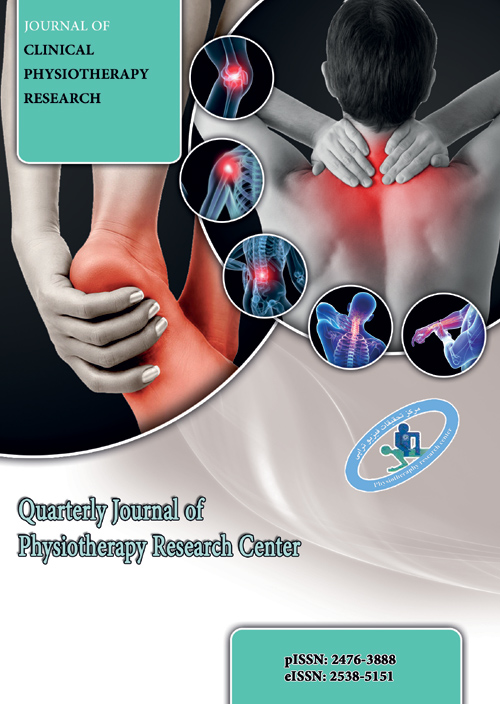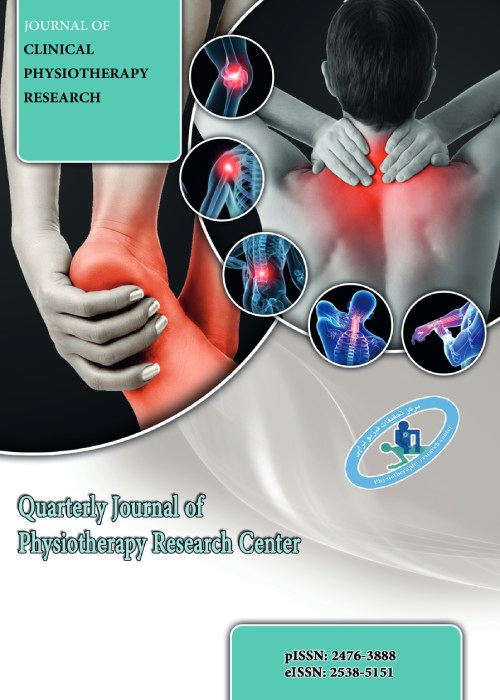فهرست مطالب

Journal of Clinical Physiotherapy Research
Volume:6 Issue: 4, Fall 2021
- تاریخ انتشار: 1401/04/21
- تعداد عناوین: 8
-
-
The effect of eight weeks of aerobic exerciseon the biomechanical variables of femoral arteriesinmiddle-aged men following percutaneous coronary interventionPage 1
Introduction &
ObjectiveAtherosclerosis is one of the leading causes of cardiovascular disease and research has shown that regular physical exercise with appropriate intensity and duration It can improve cardiovascular function, especially in patients with atherosclerosis, but little research has been done on the effect of different exercises (aerobic, resistance and strength) on arterial biomechanics (peripheral and central) and there are contradictory results. In addition, few studies have been done on middle-aged people. The main purpose of this study was to evaluate the effect of eight weeks of aerobic training on selected variables bilateral femoral artery biomechanics in middle-aged men, three to seven days after coronary angioplasty.
MethodologyThirty patients with coronary angioplasty who underwent coronary angioplasty, ranging in age from 45 to 60 years, were randomly selected from the patients referred to the Rehabilitation Clinic of Tehran Cardiac Center. Arterial resting lumen diameter(LD) in systolic and diastolic phases and intima-medial thickness(IMT) of bilateral femoral artery, compliance and ratio of intima-media thickness to lumen diameter(IMT/LD) were measured before and after exercise. The aerobic exercise program was performed for eight weeks and three sessions per week, each session lasting 40 minutes on three devices: treadmills, an arm ergometer and a workhorse, for each patient. In this study, analysis of covariance tests at the significance level of 0.05, paired t-test and Will Coxon test were used.
ResultsThe results showed that aerobic exercise on selected variables of vascular biomechanics [resting lumen diameter in systolic and diastolic phase] , Was confirmed at the significance level of 0.05 and Although the effect of aerobic exercise was not significant in some variables of vascular biomechanics [compliance and ratio of intima-media thickness to lumen diameter] . in some angioplasty patients; But in general, all variables have improved in order to improve and reach the norm of normal people.
ConclusionThe present study concluded that aerobic exercise improves the biomechanical condition of the arteries and suggests that performing consistent exercises having is of paramount importance in heart patients to prevent further heart attacksheart patients.
Keywords: Coronary angioplasty, Femoral artery, Aerobic exercise, Middle-aged man, Vascular biomechanics -
Asymmetrical bilateral traumatic hip dislocation with posterior column acetabulum fracture, report of a rare casePage 5
Bilateral asymmetric hip dislocations are rare in comparison to unilateral dislocations. We present the case of a 20-year-old man who suffered from asymmetrical bilateral hip dislocation, anterior dislocation on the left, and posterior dislocation of acetabulum fracture on the right. In the operating room, all hip dislocations were manually decreased, and skeletal traction was used due to weakness on the right side. A week later, an open reduction and internal fixing were applied to the posterior wall and column fracturing of the right acetabulum
Keywords: hip -
Page 43Introduction
Symmetry and asymmetry of lower limbs are introduced as main critical challenges of human movement. The aim of this study was to compare the kinematic symmetry of lower limbs during running at different speeds.
Material and MethodsThe study was conducted as a quasi-experimental design. Twenty-eight professional runners (aged: 34.75±6.63 years) voluntarily participated in this study. Running at three progressive speeds (2.5, 3.5 and 4.5 m/s) was conducted by each subject on a treadmill while kinematic data were captured at 150 Hz. Peak angle of hip, knee and ankle joints during flexion were derived in the stance phase of running. Independent T-test were performed to examine the symmetry of peak flexion angles of hip, knee and ankle joints during running at different speeds using SPSS ver. 22 (P<0.05).
ResultsFindings showed no significant difference between two limbs in peak flexion angles of lower joints at every speed.
ConclusionsSymmetry exists in peak flexion angles of lower joints in stance phase during running at the different progressive speeds. Coaches and biomechanists would achieve benefits of kinematic symmetry of lower joints in order to prevent injuries and optimize athletes’ running performance.
Keywords: Biomechanics, Kinematics, Lower Joints, Running, Symmetry -
Page 45Introduction
shoulder muscle fatigue in exercise is very common among bodybuilders. Fatigue can lowers the performance quality and seriously damage athletes’ shoulder joints. This study aimed to determine the effect of fatigue on the force of flexor, extensor, elevator, depressor, retractor, and abductor shoulder muscles in young bodybuilders after a session of debilitating fatigue.
Materials and MethodsIn this quasi-experimental study with a pre-test and post-test design, 25 active athletes in the field of bodybuilding (age: 26.12±2.78 years, height: 1.82±0.035 m, weight: 78.92±4.23 kg, BMI: 23.71±1.40 kg / m2, and sport history: 2.96±0.97 years) were selected. Before and after the fatigue, the force of flexor, extensor, elevator, depressor, retractor, and abductor muscles of shoulder was evaluated using a portable tensile-compression tachometer. To analyze the statistical part, the paired samples t-test was used to compare the fatigue protocol.
ResultsThe results of the study showed a reprise of debilitating fatigue reduced the force of flexor (P=0.001), extensor (P=0.001), elevator (P=0.001), depressor (P=0.001), retractor (P=0.001), and abductor (P=0.001) of shoulder muscles.
ConclusionIn general, the results of the present study showed the effect of fatigue on the reduction of flexor, extensor, elevator, depressor, retractor and abductor muscles of the shoulder, and this force decrease can be a factor for reducing performance quality in fatigue conditions and probably increasing the risk of injury in athletes.
Keywords: Bodybuilding, Force, Fatigue, Shoulders -
Page 48Background and Aim
increasing running speeds are associated with impulse variability and will lead to increasing impulse. The purpose of this study was to investigate about the impulse variability following velocity increase.
Materials and Methods28 elite runners (body mass: 69.63 ± 6.670 kg), (age: 34.75 ±6.626 years) and (Height: 175.96 ± 6.74 cm), participated in the present study, voluntarily. The force data were measured with a sampling frequency of 300 Hz while running on a treadmill by a force plate, then the impulse and mean impulse variables were extracted. Analysis of Variances with repeated measurements with a significant level (p <0.05) was used to analyze the data.
ResultsThese results showed that with increasing velocity in the Impulse stance phase, there is a significant difference between the velocities of 3.5 and 4.5 m / s and increasing the velocity from 3.5 m / s to 4.5 m / s. Increases.
ConclusionIt seems that a change in running speed causes a change in the momentum of the running support phase and increases with increasing impulse speed.
Keywords: Impulse, Biomechanics. Running, kinetics -
Page 49Objective
The ankle and the leg have the capability to perform specific functions such as carrying the weight of the body in the standing position against the power of gravity, moving the body to the front and creating stability for keeping the balance and controlling the posture. The purpose of the present study is Symmetry Comparison Balance performance and plantar pressure Distribution in Active adolescent’s female with Ankle Pronation while standing and Stance phase of Gait.
Materials and MethodsThis study was semi - experimental with 34 active adolescent girls between 14 and 17 of Tehran were selected as simple and available. In order to evaluate the navicular drop measurement by Bordy method, evaluation of plantar pressure distribution by Foot Pressure device (PT-Scan4452F100) and to evaluate the symmetry between the two limbs and balance function were used the symmetry Index and Balance performance formula. Mean and Deviation was used to describe data, Shapiro-Wilk Test applied to verify the normality od the data, and independent t-test was compare the variable of the two groups at significance level of p≥0/05.
ResultsThe results Symmetry Comparison Balance performance and plantar pressure Distribution showed that, there was significant difference in Symmetry meteteas 1 (P≥ 0.03) and Symmetry medial hell foot (P= 0.04) and presser of hell foot percent Symmetry (P= 0.04), Symmetry hell foot impulse (P= 0.04) and rotation hell foot balance (P= 0.04) in two groups Active adolescent’s female with Ankle Pronation.
ConclusionThe current study’s findings showed that the girls with the pronation anomaly had less asymmetry on the inside of the heel and increased pressure distribution on the 1st. tarsus and the symmetry of balance function of heel rotation around the ankle’s axis and the impulse of the back of the foot in the healthy group were more than in the pronation group. Furthermore, because of more contact of the inner surface of the soles with the ground in the adolescent girls with pronation, the pressure level on the inner edge and 1st. metatarsus is increased and the inner heel symmetry in the pronation group decreased compared to the healthy group.
Keywords: Symmetry, pressure distribution, Pronation, Female Adolescents, Active -
Page 50Objective
The main objective in this study was determination of the results of early versus delayed rehabilitation in surgical treatment of patients with ankle fracture. Methods and materials: This retrospective cohort was conducted among 38 patients with ankle fracture referred to Taleghani Hospital in Tehran since 2014 to 2019. The outcomes including functional factors and pain, bulging, and stiffness were assessed and compared across the groups.
ResultsOf 38 study patients, 30 were men (78.95%) and 8 were women (21.05%) with the mean age of 32 years. The pain (P=0.006), running (P=0.035), support (P=0.003), daycare (P=0.001), and total point (P=0.001) was significantly higher in intervention group with weight bearing after two weeks. The other variables were not differed (P > 0.05).
ConclusionsTotally it may be concluded that results of early rehabilitation in surgical treatment of patients with ankle fracture is better than delayed rehabilitation and use of this method is recommended.
Keywords: Ankle Fracture, Rehabilitation, Treatment -
Page 52
Osteoid osteoma is a moderately common bone lesion, accounting for 10-12% of benign bone tumors (1, 2). It primarily affects young people in their first two decades of life, with the majority of cases occurring between the ages of 5 and 30 (3). Men are 2-4 times more likely to be affected than women (4). The tumor can develop in almost any bone in the body; however, in more than 70% of cases, the long bones are the source of the tumor, with the femur and tibia being the most frequently affected (50-60%). The diaphysis or metaphysics of long bones are the most common sites for osteoid osteomas. With a frequency of around 10-13%, epiphyseal and intra-articular locations are deemed rare, with the hip being the most common site (4-7). Other less impacted areas include the ankle, elbow, wrist, and knee. When a lesion develops at the extremity of long bones, near or inside the joint, in a bone confined by the capsule, very close to it, and to the synovia, it is classified as intra-articular (3). This condition's etiology remains unclear and the incidence of a familial occurrence is exceptionally unlikely. Cytogenetic modifications such as the deletion of chromosome 22q have been identified in cases of osteoid osteoma, although further research is needed to definitively relate this individual to a clonal mutation (8, 9).
Keywords: mass sergury


